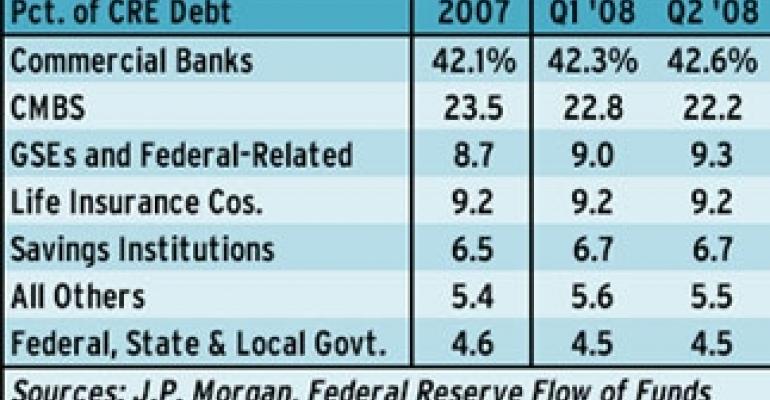The securitized debt market appears to be coming back to life.
In recent weeks, commercial-mortgage backed securities (CMBS) activity has begun to perk up. And importantly, the most recent deals have proceeded without government assistance. Bank of America is working on a $460 million issue backed by properties owned by Fortress Investment Group, a global alternative asset manager. In addition, Inland Western Retail Real Estate Trust Inc., an Oak Brook, Ill.-based non-listed REIT, closed a $625 million loan with JPMorgan Chase Bank N.A. that will be largely financed through CMBS issuance. These deals come after Developers Diversified obtained a $400 million loan two months ago that was accomplished in part through the government’s Term Asset-Backed Securities Loan Facility. All the transactions so far have involved single borrowers, but there is talk in the market that a multi-borrower CMBS transaction will emerge early in 2010.
This trickle of activity has created renewed confidence that the CMBS market is not gone for good, says Gerard Mason, executive managing director in the New York City office of Savills LLC, a real estate services provider. Still, the road to recovery will be a long one and the deals getting done today do not portend a torrent in 2010. Investors remain extremely cautious and will likely stick to single-borrower issues with great sponsorship and stabilized properties, he notes. Year-to-date in 2009, banks have issued $2.2 billion in new CMBS, according to Commercial Mortgage Alert, an industry newsletter. Next year, that number might reach $15 billion—an uptick from 2009, but still a far cry from the record $223 billion of issuances in 2007.
“I think single-borrower, well-underwritten deals with specific strategies: that’s what’s going to get done,” Mason says. “Investors are dipping their toes back into the market, but it’s sort of an embryonic market at this point. We don’t know exactly what’s going on.”

Industry experts agree that after a two-year break, investors seem ready to come back to securitized bonds. There’s little profit to be made by investing in Treasuries right now and the equities run appears to be nearly tapped out, so institutional investors are interested in an alternative with high yield potential, according to David Lynn, managing director with ING Clarion Partners, a real estate investment management firm.
Meanwhile, many of the larger national and international banks have returned to profitability this year and might be looking at securitization once again. Mason mentions Cantor Fitzgerald, Lazard and Wells Fargo among potential future participants, in addition to Goldman Sachs, Bank of America and JP Morgan, which have already announced their involvement in new CMBS deals.
Tom Fink, senior vice president with Trepp LLC, a New York City-based provider of CMBS and commercial mortgage information, says that the firm’s clients on the issuer side are already starting to put more deals in motion, including multiple-borrower CMBS issues. “I think there will be demand for [those], but it will require that you have a strong origination sponsor that has the ability to underwrite the balance sheet and securitize on the same basis,” he says. “Transactions that were successfully done in 2006 and 2007 would not stand a chance in 2010,” he adds.
Investors have not forgotten about the money they lost because of the sloppy underwriting exercised during the 2005-2007 cycle. At least for the next several quarters, until the economy shows sustained growth and the capital markets begin to loosen up in a significant way, CMBS investors will continue to gravitate toward AAA-rated notes, backed by well-performing properties and conservative loan terms, says Sam Chandan, president and chief economist with Real Estate Econometrics, a New York City-based research firm. The Developers Diversified financing, for example, featured a loan-to-value ratio of approximately 65 percent and debt service coverage level between 1.44 and 1.52. Such strict terms might put a cap on the number of deals that come to fruition in 2010.
Moreover, because investors will watch closely over every single property that goes into new CMBS pools, multi-borrower deals will likely remain few and far between, Lynn adds. If several do go through, they might feature only two or three borrowers and include the least risky asset classes—for example multi-family. Retail is unlikely to make the grade until the unemployment outlook improves and consumers begin to show more confidence, Lynn notes. Eventually, conduit loans featuring multiple borrowers and various asset types will come back—but it’s likely to be a multi-year process.
“To me, it’s still demonstration time—it’s all about: will this work? Will investors make money? Is there quality in the underwriting? Are the ratings more accurate now?” he says. “We are in unchartered waters, and the market could be pretty choppy, so you really, really want to do your underwriting. I think it will be kind of a slow road.”
This continued sense of uncertainty is why many market experts remain in favor of the government’s Term Asset-Backed Securities Loan Facility program, even though it ended up playing a limited role in the few CMBS deals that have been announced thus far. However, keeping the program active gives banks an added level of confidence that their notes will generate some level of investor demand, says Malay Bansal, managing director of commercial real estate asset management and advisory with NewOak Capital LLC, a New York City-based advisory firm.
“I don’t think it will be a major part of CMBS emergence at all, but I don’t think it should be eliminated,” says Lynn. “It’s good to have—with the government giving some credit support in this crucial area, it signals that they think it’s important and they don’t want it to fail.”
—Elaine Misonzhnik

